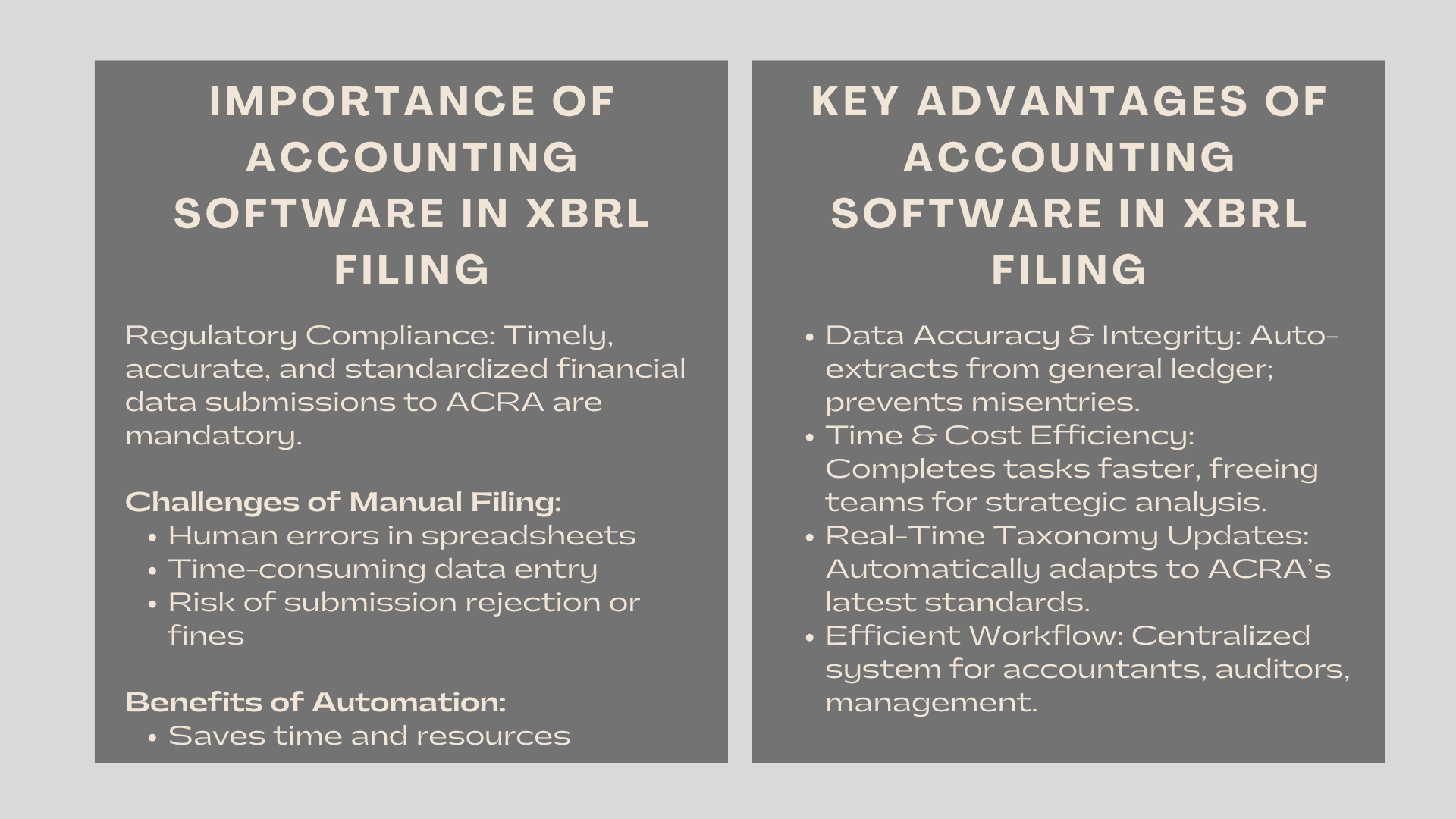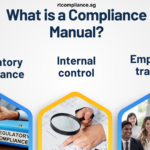The Role of Accounting Software in Automating XBRL Filing
Regulatory compliance in a rapidly digitized financial environment of Singapore has gone beyond the manual methods. The companies are now supposed to submit timely, accurate and standard financial data submissions to the Accounting and Corporate Regulatory Authority (ACRA). The adoption of accounting software to automate XBRL (eXtensible Business Reporting Language) filing is one of the major developments that can support this requirement.
To small and medium-sized enterprises (SMEs), switching to automated solutions has become a necessity, as opposed to the use of spreadsheets. XBRL filing done manually does not only take time, but it is also associated with the possibility of human error, which may result in submission rejection or imposition of regulatory fines. Automation on the other hand, along with proper training through best finance courses for small and medium-sized enterprises Singapore, is used to ensure companies save precious time and resources by ensuring that they are compliant.
This paper discusses the ease of XBRL filing with technology especially accounting software and why automation is the future of financial reporting in Singapore.

The importance of XBRL Filing to Business in Singapore.
Conceptualization of the XBRL Purpose.
XBRL is a world-recognized electronic reporting standard, which makes financial information simple to standardize, analyze, and exchange. XBRL is introduced by ACRA to make financial statements of companies transparent and efficient; it involves that companies be required to provide their financial statements in a structured and machine readable format.
The significance of Compliance.
Preparation of proper XBRL financial statements is not an administrative exercise. It assists in making sure that the corporate reporting ecosystem in Singapore is stable, reputable, and competitive at the global level. Companies that submit on time ensure their good reputation and do not get fines due to non-submission or submission of improper submissions.
The Change toward Digital Financial Reporting.
Challenges of Manual Filing
Conventionally, businesses used to use accountants to prepare and tag financial statements manually to be relayed in XBRL format. This process often involved:
- Restricting to repeated entries of data.
- Ensuring the conformance with the recent taxonomy of ACRA.
- Running repeat validity tests.
Although it is ideal in small scale, manual XBRL preparation is likely to cause anomalies, tagging mistakes and time wastage, especially in large organizations that have complicated structures.
Emerging Automation in Compliance.
In the modern era, technology is transforming the way business is conducted in regard to regulatory reporting. Accounting systems that are automated with XBRL capability make the process of extracting, validating, and submitting data easier. This makes sure that the reports are always in the right format and they are all in line with the current regulatory requirements.
Companies adopting the benefits of using accounting software for XBRL filing automation can minimize human error, cut down preparation time, and maintain better accuracy across all financial disclosures.
The main benefits of XBRL Filing using accounting software.
Improved Data accuracy and integrity.
The accounting software will automatically extract data on your company general ledger and all numbers will be absolutely accurate in line with your official account. This does not require any manual input of the data and thus chances of typing or entering some figures are eliminated.
Inconsistency is identified at an early stage of the system, and the user is able to correct it before entry. This leads to more reliable and cleaner financial reports that are not done in several rewrites to meet the standard of ACRA.
Time and Cost Efficiency
Hand preparation of XBRL may take up to several days particularly where there are a few accountants in an organisation. Automated systems save this time considerably as they create files that are of XBRL compliance through accounting data.
It is now possible to complete the process that used to take several team members in hours, which can be used to do the more valuable tasks such as financial analysis or strategic planning.
Conformity to the most recent Taxonomy.
ACRA occasionally upgrades its XBRL taxonomy to capture the change in accounting standards and reporting specifications. When automation is used, these updates will be automatically incorporated in the software and as such, will not require any manual modification in your reports.
This dynamic update capability eliminates out dated or wrong tagging which is one of the major reasons of rejected filings.
Efficient Workflow and Cooperation.
An automated accounting system can also have an approval workflow built into it, which can enable many stakeholders (p. e., accountants, auditors, and management) to access financial information at the same time.
Such a team-based model enhances accountability and transparency during the reporting period, minimizing poor communication and procrastination.
Scalability on the Expanding Businesses.
The reporting requirements of companies increase as they grow. The accounting software available on the cloud supports the business growth through scalable solutions, which process more data without compromising performance and accuracy.
This flexibility renders automation a perfect investment in the long term of SMEs aspiring to make their compliance processes future-proof.
How Automation Improves the Efficiency of XBRL Reporting
Implementing the how automation improves XBRL reporting efficiency for SMEs approach transforms compliance into a streamlined, strategic function rather than a tedious obligation.
On-the-fly Data Synchronization.
The accounting systems that are presently in use are meant to update financial records instantly. It translates to the fact that companies will have the ability to create near real time financial statements and hence the data that will be used in the XBRL filing is always updated and precise.
Audit preparation is also easier because financial information is always the same within all the reports and systems and this is because of real-time synchronization.
Smart Tagging and Authentication.
The automated software is able to identify certain financial line items and apply appropriate XBRL tags automatically. This smart tag allows removing manual mapping and human workload is greatly reduced.
In addition, the software has validation tools that detect missing or misaligned fields and avoid submission errors prior to their occurrence.
Document Management-Centralized.
Automation brings it all together, all financial documents including trial balances and supporting schedules are put in single digital system. This enhances accessibility as well as keeps a record of all versions of the document to be approved and kept in a secure location.
With such centralization, future filings will be easier and the auditors or regulators will be able to access the needed information in a timely manner.
Connection with the BizFinx System of ACRA.
The majority of accounting services applied in Singapore today are directly connected to the BizFinx portal of ACRA. This enables business to create, validate and submit XBRL files without necessarily uploading them manually, reducing the time taken in submission and possible formatting problems.
Addressing Obvious Implementation Problems.
Although automation has many advantages, there are also business obstacles that firms may experience during their switching of manual processes to digital processes. Common concerns include:
- Software selection: It is necessary to select an accounting solution that is reliable, and compliant with ACRA.
- Training requirements: The personnel should be taught on how to use new tools.
- Data migration: It is important to plan on how to convert the old accounting data into electronic formats.
The latter can be addressed by engaging the services of seasoned accounting service providers in the field of XBRL automation. They take the businesses through installation, configuration, as well as continuous compliance oversight.
Digital Compliance in Singapore, Future.
With the ongoing digitalisation in Singapore, the future of financial compliance lies in the XBRL filing automation. With the introduction of artificial intelligence (AI) and machine learning, it will become even more accurate and allow making predictions and identify errors in financial data.
By automating their operations, only businesses that do so will stay on the right side of the law but also experience a competitive advantage in terms of efficiency, data transparency, and the ability to make critical decisions.
Conclusion to The Role of Accounting Software in Automating XBRL Filing
The automation has transformed how businesses manage the XBRL filing and turned the whole process of compliance into an automated, technology-based task. Having embraced the advantages of XBRL filing system automation provided by accounting software and learning how automation saves time in XBRL reporting to SMEs, businesses can be sure of high accuracy, less time spent in filling in the data, and keep abreast with the dynamic nature of the ACRA regulations.
To the Singapore companies, and more so, SMEs, automation is not just a regulatory measure but a strategic choice that helps to promote the rise and expansion, stability, and financial sustainability of the company in the long term.




